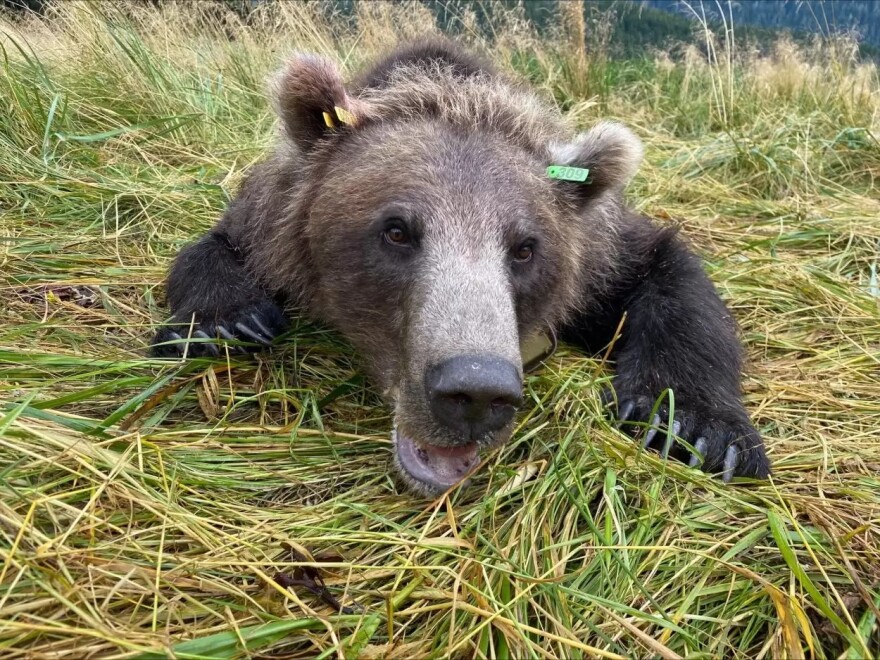Biologists have launched the first-ever state study of brown bear numbers on Sitka’s Baranof Island. Managers say they need updated data to manage the population appropriately.
Baranof Island is really big — about 1,600 square miles and larger than the state of Rhode Island. The brown bear population is currently managed using really old numbers based on populations from a different island, measured nearly 40 years ago.
Stephanie Sell, a wildlife research biologist with the Alaska Department of Fish and Game, said there’s never been a population estimate study completed on Baranof.
“The management numbers that we’re using for brown bears on Baranof were extrapolated from a project that happened on northern Admiralty (Island) in the late 1980s and the early 1990s,” Sell said.
There was a track study in the 1930s, where researchers went up salmon streams to measure the widths of paw pads to determine how many animals were on the island, but modern research techniques invalidate it.
Based on the information they found on nearby Admiralty Island — located between Sitka and Juneau — Sell said researchers determined there was likely more suitable habitat on Baranof, meaning more bears.
The number they settled on? 1,045.
But Sell said they really don’t know how accurate that number is. And to be able to sustainably manage brown bears on the island, it’s really important to have updated information.
“What we’re trying to do is figure out what those numbers are,” she said.
Sell estimates the study will take about five to six years to complete. Biologists recently wrapped a similar six-year project near Haines and Skagway. Sell said ADF&G had been managing for a population of 400 bears in the area, but the study led them to lower that estimate to just over 300.
“I don’t know if it’s going to be more or less on Baranof Island, but that’s what this project is going to hopefully find out,” she said.
The price tag on the study is still unknown, according to Sell, but they have a funding source: the Pittman-Robertson Wildlife Restoration Act, which is supported by federal excise taxes on the sale of ammunition and firearms.
In early September, Sell and her assistant began capturing brown bears near Sitka and putting GPS collars on them to learn more about their habitats and day-to-day movements.
“We use helicopters wherever we can to dart bears, and then it takes us about an hour to process the bears,” she said. “We also use foot snares in places where we won’t run into people, for safety reasons. And then the other method is free range darting, where we sit next to some sort of salmon stream or some sort of attractant, where the bear is drawn in by some natural food source, and we just wait for bears to show up.”
Each of the 25 bears they aim to capture each year will wear a collar for up to two years. When they retrieve them, researchers will then be able to look at that data and focus their efforts on the next part of the study: genetics.
“Once we get more spatial data and see where bears are moving across the island, we can start looking at where we’re going to actually put genetic sampling detectors,” Sell said. “We’re going to start catching bear hair to increase our sample size, and that way we can use that information to determine how many animals are actually on the island.”

Sell said Baranof bears are generally really dark, almost resembling black bears. They’re also quite fat this time of year because of the island’s healthy salmon runs — something she said they didn’t see everywhere else this year.
“What we do know about Game Management Unit Four bears is that they’re genetically similar to polar bears,” Sell said. “They had refugia, it seems like, since the last ice age. And so they’re genetically different from mainland bears.”
(Refugia are geographical areas where a population, species or community has survived environmental instabilities over long periods of time.)
As of Friday, Sell said biologists have put 20 collars on bears: 14 on females and six on males.
Brown bear hunting season in Sitka starts on Sept. 15. Hunters are currently able to harvest 42 bears on Baranof — that’s 4% of the estimated population. Sell said they hope to be done tagging for the season before that begins.
Later on in the study, she said they’ll be reaching out to the community to see if anyone wants to volunteer by checking hair snares. If anyone has questions, wants to volunteer, or even give her a guesstimate on how many bears they think might be on Baranof Island, Sell said they can email her.

